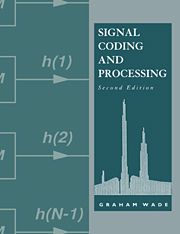Book contents
- Frontmatter
- Contents
- Preface
- Abbreviations
- 1 PCM signals and systems
- 2 Source coding
- 3 Channel coding
- 4 Digital filters
- 5 Discrete transforms
- Problems
- Appendix A Transposition of digital filters using signal flow graphs
- Appendix B Fixed-point arithmetic
- Appendix C C-routine for FIR filter design
- Appendix D C-routine for DIT in-place radix-2 FFT
- Appendix E C-routine for Meggitt decoder simulation
- References
- Index
4 - Digital filters
Published online by Cambridge University Press: 05 June 2012
- Frontmatter
- Contents
- Preface
- Abbreviations
- 1 PCM signals and systems
- 2 Source coding
- 3 Channel coding
- 4 Digital filters
- 5 Discrete transforms
- Problems
- Appendix A Transposition of digital filters using signal flow graphs
- Appendix B Fixed-point arithmetic
- Appendix C C-routine for FIR filter design
- Appendix D C-routine for DIT in-place radix-2 FFT
- Appendix E C-routine for Meggitt decoder simulation
- References
- Index
Summary
We start by defining some important terms in digital filter theory.
A sampled data filter is an algorithm for converting a sequence of continuous amplitude analogue samples into another (analogue) sequence. The filter output sequence could then be lowpass filtered to recover a continuous time or analogue signal, and the overall filtering effect will be similar to that of conventional analogue filtering in the sense that we can associate a frequency response with the sampled data filter. In Section 4.1 we develop a formal discrete time linear filter theory based upon the concept of sampled data filtering.
Usually the signal is both sampled and quantized and the filter input is actually a sequence of n-bit words. The filter is then referred to as a digital filter, and it could be implemented in digital hardware or as a software routine on a DSP chip. For generality, the basic digital filter theory developed in Section 4.1 neglects quantization effects and treats the digital filter as a sampled data filter.
A practical example of a true sampled data filter is the CCD transversal filter used for ghost reduction in television receivers. Here, CCD rather than digital technology is sometimes preferred because it offers a long delay time in a small chip area with low power consumption. Examples of digital filters abound. Adaptive digital filtering can be used to reduce the noise level in aircraft passenger compartments (using adaptive acoustic noise cancellation), and adaptive transversal digital filters can be used for equalization of telephone lines.
- Type
- Chapter
- Information
- Signal Coding and Processing , pp. 225 - 331Publisher: Cambridge University PressPrint publication year: 1994



